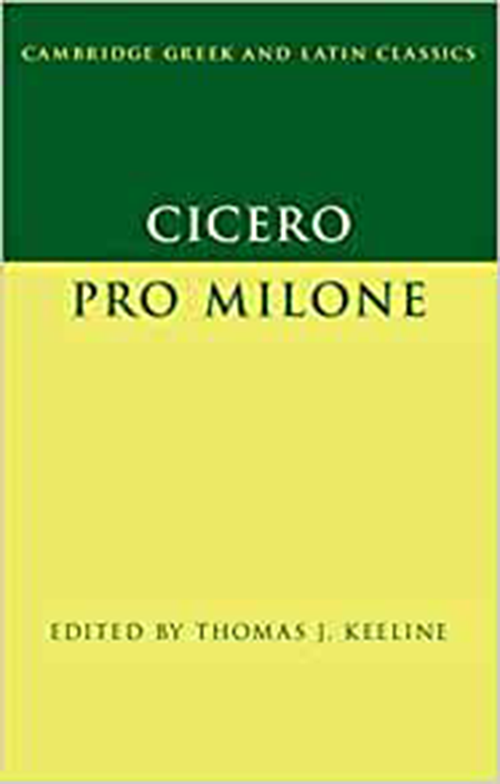
Cambridge Greek and Latin Classics has released a new text and commentary for Cicero's Pro Milone, edited by Thomas J. Keeline, the first such full-scale commentary in English in (according to Keeline's reckoning) 126 years. Keeline, the author of the successful and engaging The Reception of Cicero in the Early Roman Empire (Cambridge 2018), may have well written a commentary that will last another century. In this review, I will pick out but a few of this magisterial commentary's many merits and speak to its power as a superb teaching document. However, I will also note the importance of a teacher's guidance for students when using it: unlike other entries in the CGLC, the commentary can run at a very high academic register for students.
First, a brief background. Cicero's Pro Milone, sometimes thought Cicero's ‘perfect’ speech owing to its neat-and-tidy ordering according to ancient rhetorical forms, finds Cicero defending Titus Annius Milo, a seedy Ciceronian ally, then praetor, accused of murder. The victim was Publius Clodius Pulcher, a powerful populist politician and Cicero's agitator and arch rival in the 50s BCE. The rhetorical perfection of the speech is pitched against the grim reality of Milo's deeply imperfect politics and character. Keeline keeps this in clear view. In fact, that Cicero's case involved defending a person clearly guilty of a capital crime—who nevertheless then became the subject of one of his finest rhetorical displays—is sometimes thought in part to explain its popularity.
The circumstances of its delivery, too, were extraordinary (even by the standards of the increasingly alarming political situation of the late Republic). Street violence and open intimidation had reached a fever pitch in the wake of Clodius’ brutal murder on the Appian Way by Milo's band. Ancient sources tell of a rattled Cicero, trying his best to be heard over the constant jeers and heckling of the Clodian partisans assembled at the trial. Pompey himself watched over the proceedings. The result, despite Cicero's defence, was guilty, 38 votes to 13.
Despite the practical failure of the speech in securing acquittal for Milo, the Pro Milone has had a sparkling afterlife. Keeline gives ample citations for the effusive praise rendered unto it—not simply a good speech, the Pro Milone has been thought, perhaps, to embody the ‘ideal speech’ of the ‘ideal orator’. Needless to say, the commentary tradition on it and academic attention paid to it are vast. Keeline's commentary is now the standard guide.
Keeline's brilliant introduction and extensive commentary succeed in nearly every respect imaginable for a historico-philological companion. For Pro Milone’s roughly 30 pages of Latin text, there are close to 300 pages of commentary, indices, maps, and works cited. The commentary is simply brimming with first-rate philological, historical, and rhetorical analysis.
These 300 pages do not include the 50-page introduction, which is a masterful piece of scholarship by any measure. Particularly helpful are Keeline's marvellous summary of the complicated, thorny political situation of the 50s BCE, a helpful historical timeline, and an exacting outline of the speech according to its rhetorical layout (dispositio).
For a commentary pitched at satisfying the needs of a traditional philologist, this reader greatly appreciated Keeline's discussion of the real challenges attendant with reading the Pro Milone (not simply analysing it philologically). Keeline cites with approval clear and convincing research from Second Language Acquisition (SLA) that shows that real comprehension of a text usually does not occur until 95-97 percent of the text's vocabulary has been acquired. Once we understand the implications of this, it can radically change our perception of what reading classical languages would look like (and how we might get closer to the goal—even if, as Keeline has argued elsewhere, near-native reading proficiency is of course out of the question). While Keeline does not focus on this point, it is powerful to see SLA's inclusion in the pages of CGLC.
I end with one cautionary note for those teachers looking to include Pro Milone in their next undergraduate course and excited to pick up this (fabulous) piece of scholarship. In putting myself in the shoes of a younger reader, I found myself thinking that this commentary, at times, tends toward servicing the scholar more than the student. The introduction, for example, is exceedingly well-researched—and at times exceedingly exacting. An undergraduate reader may be overwhelmed by the sheer volume of citations and, frankly, its magisterial scope. The commentary, too, surveys the scholarly literature with nothing other than full command—but it is an open question as to how useful this command is for the typical upper-level Latin undergraduate. Accordingly, I here recommend that teachers be prepared to assign this commentary with an understanding that they may well need to further scaffold or grade the commentary for greater accessibility for every upper-level Latin student.
In sum: this is one of the finest commentaries to cross my desk. It will be of use for every student and scholar of Cicero's rhetoric, particularly the Pro Milone, of course, for generations.


